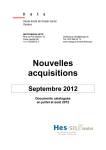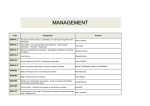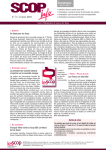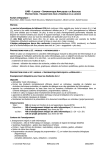Download Optimisez vos processus administratifs
Transcript
Maurice AUMAGE Optimisez vos processus administratifs © Éditions d’Organisation, 2004 ISBN : 2-7081-3050-1 SOMMAIRE Avant-propos . . . . . . . . . . . . . . . . . . . . . . . . . . . . . . . . . . . . . 1 Les 10 composantes du processus administratif . . . . . . . . . . . 2 PREMIÈRE PARTIE LES OUTILS DE L’OPTIMISATION DU PROCESSUS ADMINISTRATIF Chapitre 1. LE FACTEUR HUMAIN DANS LE PROCESSUS D’ORGANISATION ADMINISTRATIVE © Éditions d’Organisations 1. La place du processus administratif dans l’entreprise . . 9 2. Le rôle prépondérant de la hiérarchie . . . . . . . . . . . . . 11 3. La posture délicate du conseiller en organisation . . . . . 12 3-1. Être sûr de soi . . . . . . . . . . . . . . . . . . . . . . . . . . . . 13 3-2. Rassurer les collaborateurs. . . . . . . . . . . . . . . . . . . 14 3-3. Rapporter le problème étudié à quelque chose de connu . . . . . . . . . . . . . . . . . . . . . . . . . . . . . . . . 15 3-4. Ne pas jouer à l’homme miracle . . . . . . . . . . . . . . 15 3-5. Informer . . . . . . . . . . . . . . . . . . . . . . . . . . . . . . . . 16 3-6. Faire participer. . . . . . . . . . . . . . . . . . . . . . . . . . . . 17 3-7. Démystifier . . . . . . . . . . . . . . . . . . . . . . . . . . . . . . 19 3-8. Faire adhérer . . . . . . . . . . . . . . . . . . . . . . . . . . . . . 20 Chapitre 2. LES ÉTAPES DE LA RÉORGANISATION DU PROCESSUS ADMINISTRATIF 1. L’indispensable diagnostic préalable . . . . . . . . . . . . . . . 25 1-1. Définition du cadre de l’intervention . . . . . . . . . . . 25 1-2. Recherche des causes à l’origine du problème ?. . . 27 1-2-1. Causes externes . . . . . . . . . . . . . . . . . . . . . 27 V Optimisez vos processus administratifs 1-2-2. Causes internes. . . . . . . . . . . . . . . . . . . . . . 27 1-2-3. Causes structurelles . . . . . . . . . . . . . . . . . . 28 1-3. Recherche des limites de la mission d’organisation . . . . . . . . . . . . . . . . . . . . . . . . . . . . 29 1-4. Ébauche des principes d’intervention . . . . . . . . . . . 29 1-5. Définition des moyens à mettre en œuvre . . . . . . . 30 1-6. Définition du programme d’action . . . . . . . . . . . . . 30 1-7. Utilisation du diagnostic . . . . . . . . . . . . . . . . . . . . 32 2. Le plan d’action en 5 phases . . . . . . . . . . . . . . . . . . . . . 34 2-1. Le choix . . . . . . . . . . . . . . . . . . . . . . . . . . . . . . . . 36 2-2. L’analyse . . . . . . . . . . . . . . . . . . . . . . . . . . . . . . . . 37 2-3. La critique constructive . . . . . . . . . . . . . . . . . . . . . 38 2-4. La conception . . . . . . . . . . . . . . . . . . . . . . . . . . . . 41 2-5. Les essais . . . . . . . . . . . . . . . . . . . . . . . . . . . . . . . 42 1. La structure (ou l’organigramme). . . . . . . . . . . . . . . . . 50 1-1. Les liaisons . . . . . . . . . . . . . . . . . . . . . . . . . . . . . . 50 1-2. Les collaborateurs . . . . . . . . . . . . . . . . . . . . . . . . . 51 1-2-1. La structure hiérarchique . . . . . . . . . . . . . . 53 1-2-2. Le nombre de liaisons hiérarchiques par collaborateur . . . . . . . . . . . . . . . . . . . . 55 1-2-3. Le nombre de niveaux hiérarchiques . . . . . . 57 1-2-4. Les liaisons fonctionnelles . . . . . . . . . . . . . 58 1-2-5. L’organigramme ou la visualisation de la structure. . . . . . . . . . . . . . . . . . . . . . . 60 1-2-6. La structure dans la réalité . . . . . . . . . . . . . 63 1-2-7. Comment révéler la structure réelle ? . . . . . 64 VI © Éditions d’Organisations Chapitre 3. STRUCTURE, TÂCHE, MODE OPÉRATOIRE, OUTILS DE BASE DE L’ANALYSE DU PROCESSUS ADMINISTRATIF © Éditions d’Organisations Optimisez vos processus administratifs 1-2-8. Comment implanter une structure dans le cas idéal ? . . . . . . . . . . . . . . . . . . . . . . . . . . . . 67 1-2-9. Actualisation et surveillance de la structure. . . . . . . . . . . . . . . . . . . . . . . 68 2. La tâche . . . . . . . . . . . . . . . . . . . . . . . . . . . . . . . . . . . . . 70 2-1. L’analyste. . . . . . . . . . . . . . . . . . . . . . . . . . . . . . . . 72 2-2. L’analyse quantitative. . . . . . . . . . . . . . . . . . . . . . . 73 2-2-1. La périodicité . . . . . . . . . . . . . . . . . . . . . . . 74 2-2-2. L’importance en temps . . . . . . . . . . . . . . . . . 74 2-2-3. Le temps d’attente possible . . . . . . . . . . . . . 81 2-2-4. La quantité d’unité d’œuvre . . . . . . . . . . . . . 82 2-2-5. Les titulaires . . . . . . . . . . . . . . . . . . . . . . . . 83 3. Les modes opératoires . . . . . . . . . . . . . . . . . . . . . . . . . . 86 3-1. Les types de supports habituels de la formation . . . 87 3-1-1. La codification. . . . . . . . . . . . . . . . . . . . . . . 87 3-1-2. La circulaire . . . . . . . . . . . . . . . . . . . . . . . . 88 3-1-3. Le guide de l’employé . . . . . . . . . . . . . . . . . 88 3-1-4. La note de service . . . . . . . . . . . . . . . . . . . . 89 3-1-5. Les papiers personnels. . . . . . . . . . . . . . . . . 89 3-2. Le mode opératoire . . . . . . . . . . . . . . . . . . . . . . . . . 91 3-2-1. Mode opératoire : mode d’emploi . . . . . . . . 93 3-2-2. Le mode opératoire au service de la connaissance. . . . . . . . . . . . . . . . . . . . 96 3-2-3. Le mode opératoire au service de la formation . . . . . . . . . . . . . . . . . . . . . . 97 3-2-4. Le mode opératoire au service des contrôles . . . . . . . . . . . . . . . . . . . . . . . . 97 3-2-5. Réalisation pratique du mode opératoire . . . 98 3-2-6. Les risques engendrés par une insuffisance de modes opératoires . . . . . . . . . . . . . . . . . 106 VII Optimisez vos processus administratifs Chapitre 4. TROIS OUTILS COMPLÉMENTAIRES POUR AFFINER L’ANALYSE DU PROCESSUS ADMINISTRATIF 1. Les graphiques . . . . . . . . . . . . . . . . . . . . . . . . . . . . . . . 113 1-1. Le graphique des étapes . . . . . . . . . . . . . . . . . . . . 113 1-2. Le graphique B.G (Bernaténé et Grün) dit "graphique de processus" . . . . . . . . . . . . . . . . . . . 115 2. La loi de Pareto . . . . . . . . . . . . . . . . . . . . . . . . . . . . . . 118 3. Le questionnaire. . . . . . . . . . . . . . . . . . . . . . . . . . . . . . 122 3-1. Le choix des questions. . . . . . . . . . . . . . . . . . . . . 123 3-2. La formulation des questions . . . . . . . . . . . . . . . . 124 4. L’auto-analyse. . . . . . . . . . . . . . . . . . . . . . . . . . . . . . . . 126 Chapitre 5. POSTE DE TRAVAIL ET TABLEAUX DE BORD, OUTILS DU PILOTAGE DU PROCESSUS ADMINISTRATIF Chapitre 6. AUTOMATISATION DU TRAVAIL ADMINISTRATIF 1. Isoler un processus . . . . . . . . . . . . . . . . . . . . . . . . . . . . 159 2. Définir les caractéristiques de la machine. . . . . . . . . . 160 3. Analyse des machines appropriées. . . . . . . . . . . . . . . . 160 VIII © Éditions d’Organisations 1. Le poste de travail . . . . . . . . . . . . . . . . . . . . . . . . . . . . 129 2. Le poids du poste . . . . . . . . . . . . . . . . . . . . . . . . . . . . 135 3. Le tableau de bord . . . . . . . . . . . . . . . . . . . . . . . . . . . . 138 3-1. Construction d’un tableau de bord . . . . . . . . . . . . 140 3-1-1. Analyse des tâches et paramètres . . . . . . . 140 3-1-2. Statistiques retenues pour chaque paramètre . . . . . . . . . . . . . . . . . . . . . . . . . 145 4. Le prix de revient . . . . . . . . . . . . . . . . . . . . . . . . . . . . . 153 Optimisez vos processus administratifs 4. Prix de revient des machines envisagées . . . . . . . . . . . 161 5. Le choix . . . . . . . . . . . . . . . . . . . . . . . . . . . . . . . . . . . . 163 Chapitre 7. INFORMATISATION DU PROCESSUS ADMINISTRATIF 1. L’informatique est un outil puissant . . . . . . . . . . . . . . 165 2. Rôle de l’informatisation dans l’entreprise . . . . . . . . . 167 3. Schéma d’intervention d’un informaticien . . . . . . . . . 169 3-1. Intervention à éviter. . . . . . . . . . . . . . . . . . . . . . . 169 3-2. Conduite d’une intervention exemplaire . . . . . . . . 170 CONCLUSION DE LA PREMIÈRE PARTIE DEUXIÈME PARTIE LA MISE EN ŒUVRE DE L’OPTIMISATION DU PROCESSUS ADMINISTRATIF © Éditions d’Organisations Chapitre 8. LE DIAGNOSTIC 1. Les différentes phases du diagnostic . . . . . . . . . . . . . . 205 1-1. Le relevé de l’organigramme . . . . . . . . . . . . . . . . 205 1.2. Les postes de travail . . . . . . . . . . . . . . . . . . . . . . . 207 1-3. La mesure des effectifs . . . . . . . . . . . . . . . . . . . . 208 1-4. La qualité du travail . . . . . . . . . . . . . . . . . . . . . . . 209 1-5. La gestion de l’entité ou du service . . . . . . . . . . . 210 1-5-1. Les procédures . . . . . . . . . . . . . . . . . . . . . 210 1-5-2. Les postes de travail . . . . . . . . . . . . . . . . . 211 1-5-3. La formation . . . . . . . . . . . . . . . . . . . . . . . 211 1-5-4. La structure . . . . . . . . . . . . . . . . . . . . . . . 211 IX Optimisez vos processus administratifs 1-5-5. Le tableau de bord . . . . . . . . . . . . . . . . . . 211 1-5-6. Les prévisions . . . . . . . . . . . . . . . . . . . . . . 212 1-5-7. Les effectifs. . . . . . . . . . . . . . . . . . . . . . . . 212 1-6. L’organisation . . . . . . . . . . . . . . . . . . . . . . . . . . . 212 1-7. Le management . . . . . . . . . . . . . . . . . . . . . . . . . . 212 1-8. Les liaisons . . . . . . . . . . . . . . . . . . . . . . . . . . . . . 213 1-9. Les propositions. . . . . . . . . . . . . . . . . . . . . . . . . . 213 2. Le cahier des charges de la réorganisation . . . . . . . . . 214 2-1. Préparation psychologique . . . . . . . . . . . . . . . . . . 214 2-2. Mise en place de la structure . . . . . . . . . . . . . . . . 217 3. L’analyse du travail . . . . . . . . . . . . . . . . . . . . . . . . . . . 220 3-1. Analyse sous forme de tâches. . . . . . . . . . . . . . . . 221 3-2. Analyse sous forme de mode opératoire . . . . . . . . 225 Chapitre 9. LA FEUILLE DE POSTE 1. 2. 3. 4. 5. La responsabilité . . . . . . . . . . . . . . . . . . . . . . . . . . . . . 231 La réorientation du poste de travail . . . . . . . . . . . . . . 235 La gestion de la feuille de poste . . . . . . . . . . . . . . . . . . 236 L’enrichissement du travail . . . . . . . . . . . . . . . . . . . . . 237 La définition de fonction . . . . . . . . . . . . . . . . . . . . . . . 239 1. La formation sur le tas. . . . . . . . . . . . . . . . . . . . . . . . . 243 1-1. Les principes . . . . . . . . . . . . . . . . . . . . . . . . . . . . 244 1-2. Les procédures de mise en œuvre . . . . . . . . . . . . . 246 2. La formation générale . . . . . . . . . . . . . . . . . . . . . . . . . 249 X © Éditions d’Organisations Chapitre 10. LA FEUILLE DE FORMATION Optimisez vos processus administratifs Chapitre 11. LE TABLEAU DE BORD 1. La gestion d’un tableau de bord . . . . . . . . . . . . . . . . . 251 2. Cas d’un service unique. . . . . . . . . . . . . . . . . . . . . . . . 256 3. Cas d’un service reproductible dans plusieurs implantations géographiques . . . . . . . . . . . . . . . . . . . . 257 Chapitre 12. PRÉVISION DU SERVICE ADMINISTRATIF 1. L’évolution continue du service . . . . . . . . . . . . . . . . . . 261 2. L’évolution discontinue du service . . . . . . . . . . . . . . . . 262 CONCLUSION . . . . . . . . . . . . . . . . . . . . . . . . . . . . . . . . . 263 Tableau synthétique du degré d’organisation d’un secteur administratif . . . . . . . . . . . . . . . . . . . . . . . . . . . . . . . . . . . 266 TROISIÈME PARTIE L’AIDE-MÉMOIRE © Éditions d’Organisations Chapitre 13. LES OUTILS EN BREF 1. 2. 3. 4. 5. 6. 7. 8. 9. Les huit outils de gestion . . . . . . . . . . . . . . . . . . . . . . . 272 Liste des tâches. . . . . . . . . . . . . . . . . . . . . . . . . . . . . . . 273 Mode opératoire . . . . . . . . . . . . . . . . . . . . . . . . . . . . . . 273 La structure du service . . . . . . . . . . . . . . . . . . . . . . . . 274 Les postes de travail . . . . . . . . . . . . . . . . . . . . . . . . . . . 274 La formation immédiate (formation sur le tas). . . . . . 275 Le contrôle des effectifs d’appoint. . . . . . . . . . . . . . . . 276 Le tableau de bord . . . . . . . . . . . . . . . . . . . . . . . . . . . . 276 La prévision du service . . . . . . . . . . . . . . . . . . . . . . . . 278 XI Optimisez vos processus administratifs Chapitre 14. LA MISE EN PLACE EN BREF 1. Une mise en place rapide . . . . . . . . . . . . . . . . . . . . . . . 279 2. Les gains de la réorganisation . . . . . . . . . . . . . . . . . . . 280 ANNEXES ANNEXE 1. Méthodologie recommandée pour l’élaboration des cahiers des charges informatiques . . . . . . 283 ANNEXE 2. Exemple type de charte sécurité informatique . . . . . . . . . . . . . . . . . . . . . . . . . 286 ANNEXE 3. Contrat de prestation de service informatique . . . . . . . . . . . . . . . . . . . . . . . . . 290 © Éditions d’Organisations INDEX . . . . . . . . . . . . . . . . . . . . . . . . . . . . . . . . . . . 299 XII


















